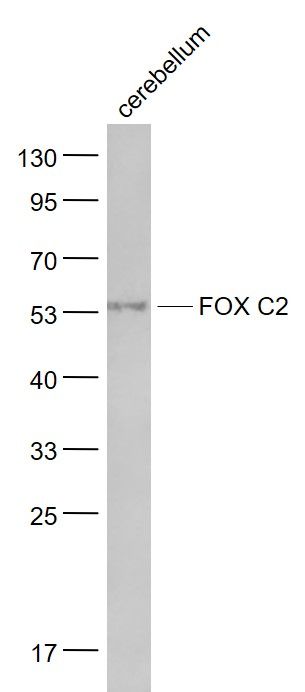FOX C2 Polyclonal Antibody
Purified Rabbit Polyclonal Antibody (Pab)
- SPECIFICATION
- CITATIONS
- PROTOCOLS
- BACKGROUND

Application
| WB, IHC-P, IHC-F, IF, ICC, E |
|---|---|
| Primary Accession | Q99958 |
| Reactivity | Rat, Bovine |
| Host | Rabbit |
| Clonality | Polyclonal |
| Calculated MW | 53 KDa |
| Physical State | Liquid |
| Immunogen | KLH conjugated synthetic peptide derived from human FOX C2 |
| Epitope Specificity | 101-200/501 |
| Isotype | IgG |
| Purity | affinity purified by Protein A |
| Buffer | 0.01M TBS (pH7.4) with 1% BSA, 0.02% Proclin300 and 50% Glycerol. |
| SUBCELLULAR LOCATION | Nucleus. |
| SIMILARITY | Contains 1 fork-head DNA-binding domain. |
| DISEASE | Defects in FOXC2 are the cause of lymphedema hereditary type 2 (LMPH2) [MIM:153200]; also known as Meige lymphedema. Hereditary lymphedema is a chronic disabling condition which results in swelling of the extremities due to altered lymphatic flow. Patients with lymphedema suffer from recurrent local infections, and physical impairment. Defects in FOXC2 are a cause of lymphedema-yellow nails (LYYN) [MIM:153300]. LYYN is characterized by yellow, dystrophic, thick and slowly growing nails, associated with lymphedema and respiratory involvement. Lymphedema occurs more often in the lower limbs. It can appear at birth or later in life. Onset generally follows the onset of ungual abnormalities. Defects in FOXC2 are a cause of lymphedema-distichiasis (LYD) [MIM:153400]. LYD is characterized by primary limb lymphedema usually starting at puberty (but in some cases later or at birth) and associated with distichiasis (double rows of eyelashes, with extra eyelashes growing from the Meibomian gland orifices). |
| Important Note | This product as supplied is intended for research use only, not for use in human, therapeutic or diagnostic applications. |
| Background Descriptions | FOXC2 is a member of forkhead/winged helix transcription factor family, whose members serve as key regulators in embryogenesis and cell differentiation (3). FOXC2 functions as a key regulator of adipocyte metabolism by increasing the sensitivity of the beta-adrenergic-cAMP-protein kinase A (PKA) signaling pathway through alteration of adipocyte PKA holoenzyme composition (4). Increased FOXC2 levels, induced by high fat diet, seem to counteract most of the symptoms associated with obesity (4). FOXC2 expression is also associated with the early stage of chondrogenic differentiation both in vivo and in vitro (3). FOXC2 haploinsufficiency results in Lymphedema-distichiasis (LD), an autosomal dominant disorder that classically presents as lymphedema of the limbs, and double rows of eyelashes (distichiasis) (5). Mutant mice null for FOXC2 show defects in axial and cranial skeletogenesis, suggesting a requirement of FOXC2 for skeletal tissue development (3). FOXC2 interacts with FOXC1 in the Notch signaling pathway (1) and in kidney and heart development (2). |
| Gene ID | 2303 |
|---|---|
| Other Names | Forkhead box protein C2, Forkhead-related protein FKHL14, Mesenchyme fork head protein 1, MFH-1 protein, Transcription factor FKH-14, FOXC2, FKHL14, MFH1 |
| Dilution | WB=1:500-2000,IHC-P=1:100-500,IHC-F=1:100-500,ICC=1:100-500,IF=1:100-500,ELISA=1:5000-10000 |
| Storage | Store at -20 ℃ for one year. Avoid repeated freeze/thaw cycles. When reconstituted in sterile pH 7.4 0.01M PBS or diluent of antibody the antibody is stable for at least two weeks at 2-4 ℃. |
| Name | FOXC2 |
|---|---|
| Synonyms | FKHL14, MFH1 |
| Function | Transcriptional activator. |
| Cellular Location | Nucleus {ECO:0000255|PROSITE-ProRule:PRU00089, ECO:0000269|PubMed:23878394, ECO:0000269|PubMed:28179430} |

Thousands of laboratories across the world have published research that depended on the performance of antibodies from Abcepta to advance their research. Check out links to articles that cite our products in major peer-reviewed journals, organized by research category.
info@abcepta.com, and receive a free "I Love Antibodies" mug.
Provided below are standard protocols that you may find useful for product applications.
If you have used an Abcepta product and would like to share how it has performed, please click on the "Submit Review" button and provide the requested information. Our staff will examine and post your review and contact you if needed.
If you have any additional inquiries please email technical services at tech@abcepta.com.













 Foundational characteristics of cancer include proliferation, angiogenesis, migration, evasion of apoptosis, and cellular immortality. Find key markers for these cellular processes and antibodies to detect them.
Foundational characteristics of cancer include proliferation, angiogenesis, migration, evasion of apoptosis, and cellular immortality. Find key markers for these cellular processes and antibodies to detect them. The SUMOplot™ Analysis Program predicts and scores sumoylation sites in your protein. SUMOylation is a post-translational modification involved in various cellular processes, such as nuclear-cytosolic transport, transcriptional regulation, apoptosis, protein stability, response to stress, and progression through the cell cycle.
The SUMOplot™ Analysis Program predicts and scores sumoylation sites in your protein. SUMOylation is a post-translational modification involved in various cellular processes, such as nuclear-cytosolic transport, transcriptional regulation, apoptosis, protein stability, response to stress, and progression through the cell cycle. The Autophagy Receptor Motif Plotter predicts and scores autophagy receptor binding sites in your protein. Identifying proteins connected to this pathway is critical to understanding the role of autophagy in physiological as well as pathological processes such as development, differentiation, neurodegenerative diseases, stress, infection, and cancer.
The Autophagy Receptor Motif Plotter predicts and scores autophagy receptor binding sites in your protein. Identifying proteins connected to this pathway is critical to understanding the role of autophagy in physiological as well as pathological processes such as development, differentiation, neurodegenerative diseases, stress, infection, and cancer.


